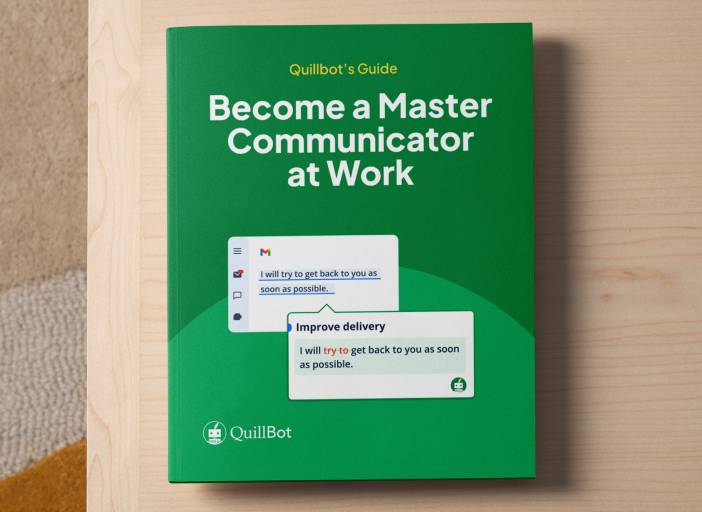What Is Copywriting?
You wake up, reach for your phone on the nightstand, and, still half-asleep, start scrolling through social media. Between your friend’s vacation photos and your cousin’s new puppy, a sleek ad catches your eye: “Skip the coffee shop line: Barista-worthy coffee at home.”
Intrigued, you tap the link, landing on a website promising ethically sourced beans with tasting notes of chocolate and blackberry. Just as you’re browsing their bestsellers, a pop-up appears: “Get 10% Off Your First Order! Enter your email to claim your discount.” Tempted by the promise of savings, you type in your address and, just like that, your next barista-worthy cup of coffee feels within reach.
Those words that pulled you from mindless scrolling, the descriptions that made you practically smell the coffee through your screen, the perfectly timed discount that pushed you from “just looking” to “customer,” that’s copywriting at work.
What is copywriting and why is it important?
Copywriting is a form of persuasive writing. Its purpose is to encourage people to take action, whether it is to make a purchase, subscribe to a newsletter, or click on a link. While the word “copy” might suggest written text, copywriting also includes spoken text like video scripts and voice-overs for commercials.
Copywriting is almost everywhere you look and listen. It’s the catchy oat milk tagline you notice at the grocery store aisle, the headline that makes you click on a link, or the ad that convinces you to try a coffee subscription you didn’t know you needed.
This doesn’t mean copywriting tricks you. Good copywriting connects what you need—even needs you might not have realized yet—with solutions that make sense for you. By breaking down complex options into simple, clear, and engaging language, copywriting helps you make decisions with ease.
What is a copywriting job?
A copywriter is a professional who uses their writing skills to help brands reach their target audience. Copywriters create marketing material like emails, ads, social media posts, or product descriptions to promote a brand, service, or cause.
Copywriters can work in various environments:
- In-house for a company’s marketing department, focusing exclusively on that brand.
- At advertising agencies, juggling multiple client accounts across industries.
- As freelancers, independently choosing projects and schedules.
A copywriting job typically involves the following:
- Writing and editing texts. Copywriters craft those coffee ads that catch your eye mid-scroll, but not on the first try. They write, delete, rewrite, and polish using tools like Quillbot’s Grammar Checker until every word earns its place.
- Research. When tasked with selling coffee pods, they don’t just describe the flavor. They research how people make morning decisions, what competitors are saying, and which words make you almost smell the coffee through your screen.
- Maintaining brand consistency. That coffee company that sounds witty and warm on Instagram? A copywriter makes sure it doesn’t suddenly sound corporate and cold in emails.
- Search engine optimization (SEO). They know exactly when to include “home coffee subscription” or “ethically sourced beans” so you find their client when searching online.
- Audience analysis. They identify the target audience’s needs and “pain points” to craft messages that connect. Which means they understand why you hate that stale office coffee or why you feel guilty about aluminum pods.
- Collaboration. They work with designers, marketing teams, and clients to make sure the copy meets the objectives and blends well with the visual elements. That steaming cup of coffee needs to be paired with the right words.
Above all, copywriters simplify complex ideas. They translate technical concepts, like brewing technology, into language that makes you nod and think, “I get it.”
Copywriting vs content writing: What’s the difference?
You shouldn’t confuse copywriting with content writing. Although both require a knack for writing, a thorough understanding of how to spark curiosity, and a careful choice of diction, their purposes differ.
In a nutshell, copywriting is about selling. Through product descriptions, emails, and social media posts, copywriters use their (typically short-form) texts to act as a bridge between a product or service and the people who need it.
Content writing, on the other hand, is about informing, educating, or entertaining readers with long-form copy. Think of how-to guides, blogs, and e-books. Rather than promoting a specific product or service, content writers play the long game: they try to attract a target audience by offering useful content to them. By providing value, they help brands build trust, establish leadership in their field, or increase their brand awareness.
Types of copywriting
Broadly speaking, we can categorize copywriting into two main types:
- Business-to-consumer (B2C): This speaks directly to individual consumers, aiming to persuade them to purchase a product or service. To succeed here, copywriters tap into emotions: excitement, curiosity, and even a little FOMO. At the same time, they try to gain the consumers’ trust by emphasizing the product’s benefits and showing its value. It’s a fine balancing act, and, for this reason, understanding your audience’s needs is key.
- Business-to-business (B2B): This one is focused on businesses that sell products and services to other businesses. The goal here is to show how a particular product or service will help solve a business problem. B2B copywriting is more educational and informational, often breaking down complex offerings into digestible, actionable insights. It’s about answering the question, “How will this make my business better?”
The field branches out further with specialized approaches that focus on different channels, like search engines and billboards, but also different modes of working, such as freelancing.
What is copywriting in marketing?
Marketing copywriting includes all the text created for marketing campaigns—from Google ads and commercials to flyers and billboards. It’s any type of copy that strategically sells products, services, or ideas to specific audiences. When a brand wants to enter a new market, copywriters also help with the localization of marketing content; they tailor it to a specific region so it feels native to the target audience while maintaining the brand’s tone of voice.
As a marketing copywriter, your job is to guide people through the marketing funnel—helping them become aware of a problem, consider your solution, make a purchase, become loyal customers, and eventually recommend your brand to others.
- Awareness: Create a social media ad with an eye-catching tagline: “Your Perfect Morning Brew, Now Guilt-Free.”
- Consideration: Develop email content highlighting key features: “Compostable Pods + Ethically Sourced Coffee = A Better Way to Start Your Day.”
- Purchase: Write compelling website copy promoting a special deal: “Try Our Pods Today: Get 15% Off Your First Order with Code FRESHPODS.”
- Loyalty: Script post-purchase emails like: “Running low? Restock now and enjoy 10% off as a returning customer.”
- Advocacy: Craft an engaging referral campaign: “Love our pods? Share with friends and earn free coffee for every referral!”
This strategy not only promotes the product effectively but also fosters a lasting connection with the customer.
What is freelance copywriting?
Freelance copywriting means that you work solo and write copy for businesses on a contract basis. This gives you a lot of freedom and flexibility as you set your own rates and decide when and where you want to work. At the same time, you also need to find clients and take care of all the administrative stuff like invoicing and bookkeeping.
Your projects depend entirely on what interests you. Some freelancers prefer website copy and blog posts, while others focus on writing snappy social captions. You may want to stick to a niche topic, like mental health, or you may choose to take on any project that comes your way—cryptocurrency this week, frozen pet food the next.
What is SEO copywriting?
SEO copywriting creates content that ranks high in search results while persuading readers to take action. It strategically uses keywords and addresses specific search intents, understanding whether someone wants to learn something, find a specific website, or make a purchase.
Good SEO writers research relevant terms and naturally weave them into headlines and body content. They balance search visibility with readability, helping businesses attract visitors who are actively searching for exactly what they sell.
- Keyword Research: First, they’d try to find out what coffee lovers are actually typing into Google. Using tools like Google Keyword Planner or Ahrefs, they’d discover people are searching for things like: “monthly coffee subscription,” “coffee pod subscription,” and “ethically sourced coffee.”
- Understanding intent: The next step would be to understand why people are searching for these terms. For example, someone searching “coffee subscription” might want convenience, while “ethically sourced coffee” appeals to values.
- Competitor analysis: They would then look at what competitors are doing. Which keywords are they targeting? How are they phrasing their ads or structuring their landing pages? This would help them identify gaps or opportunities to stand out.
- Writing the ad and the landing page: Next, they’d weave these keywords into an attention-grabbing message that still sounds natural.
What is direct response copywriting?
Direct response copy encourages readers to do something immediately, like “buy now,” “sign up today,” or “call within 24 hours.” These strong “calls to action” create a sense of urgency that pushes people to act now rather than think it over.
You’ll spot direct copy on landing pages, marketing emails, and limited-time offers. Companies love it because they can easily measure how well it works by counting clicks, calls, and conversions.
What is ad copywriting?
Ad writers have the impossible task of making you care in less time than it takes to blink, squeezing persuasion into character counts that would make X posts look wordy.
The best ad copy quickly answers:
- Who needs this?
- What problem does it solve?
- How does it solve it?
- What should you do next? (buy, subscribe, download, etc.)
This type of short-form copy shows up everywhere from search results to social feeds to podcast breaks—anywhere businesses have just seconds to grab your interest. If you have a knack for capturing a brand’s unique voice and zeroing in on exactly what problem they solve, ad copywriting could be your thing.
How AI tools are transforming copywriting
AI tools like ChatGPT or Claude have changed the way copywriters work, making some parts of the job faster and easier. Need a first draft in seconds? Done. Struggling to come up with a headline? AI can suggest a dozen. But don’t worry about robots stealing all the copywriting jobs just yet, as AI (still) has its limitations.
Here’s how AI is changing the game and where human input remains essential.
- Generate ideas: AI tools, like QuillBot AI Chat, can provide topic suggestions, headline variations, and even rough drafts, giving writers a starting point.
- Analyze content performance: AI can predict which headlines or phrases might perform better based on historical data.
- Improve copy: Tools like QuillBot’s Paraphraser can help writers edit their texts, adjust their tone, and improve their readability by suggesting alternative phrasing.
- Mimic brand voices: After analyzing existing content, tools like QuillBot’s AI copywriter can generate text in a tone consistent with a brand’s identity.
- Conduct competitor research: AI tools can scrape publicly available data from websites, like competitor landing pages, blog posts, or product descriptions. They can also summarize competitor strategies, helping writers identify gaps in messaging or untapped opportunities to stand out.
However, AI isn’t replacing human copywriters anytime soon. The best copy still requires:
- Emotional intelligence, to truly understand customer pain points and desires.
- Brand voice expertise, to maintain consistent, authentic communication.
- Strategic thinking, to align copy with broader marketing objectives.
- Creative spark that generates original ideas and approaches.
The most successful copywriters today are treating AI as a partner, not a replacement. They use AI tools to do the grunt work, like competitor analysis or grammar check, and they know how to turn stiff AI output into authentic messages by humanizing AI texts.
How to start as a copywriter
Breaking into copywriting doesn’t require fancy degrees or expensive equipment, just a computer, a willingness to learn, and a way with words. Here’s how to get started:
- Build your foundation. Take online courses, read blogs, and explore copywriting classics like Ogilvy on Advertising by David Ogilvy or The Copywriter’s Handbook by Robert Bly. Pay attention to marketing messages you see each day in your email, social media feeds, or when you Google something—what makes them work?
- Practice writing. Start with self-initiated projects if you lack professional experience. You can write for imaginary products (try a product name generator to come up with a catchy name) or volunteer for a non-profit. You can also pick a brand you admire and create a mock campaign by improving their existing copy to showcase your skills.
- Create a portfolio. Use an online platform or a simple website to display your work, ensuring it’s easy for potential clients to view and contact you
- Find your first clients. Start on freelance platforms like Upwork or Fiverr. Offer your services to local businesses or friends to build a portfolio and collect testimonials.
- Market yourself. Optimize your LinkedIn profile and connect with industry professionals. Network with designers and marketers who might need writers. Join online copywriting communities to learn and share tips.
By refining your skills, building a great portfolio, and connecting with the right people, you can start your copywriting journey with confidence.
Ask ChatGPT to summarize this page
Frequently asked questions about copywriting
- What is email copywriting?
-
Email copywriting is the process of writing and sending out emails for marketing purposes. An email copywriter needs to create appealing content that will urge current or prospective customers to act, for example, to sign up for a webinar or buy something. Email copywriting includes creating subject lines, preview text, body copy, and a clear call to action.
Quillbot’s free Grammar Checker ensures your emails are polished and professional.
- What is an example of copywriting?
-
An example of copywriting is the promotional text created for a skin care brand launching a new moisturizer. A copywriter might create a social media ad with a headline like, “Say goodbye to dry skin! Hydration that lasts all day long!” or website copy promoting an offer, “Try it risk-free! 20% off your first jar, today only!” These texts are designed to appeal to customers and drive sales.
To quickly write copy that converts, give QuillBot’s free AI copywriting tool a spin.
- What is B2B copywriting?
-
B2B copywriting, or business-to-business copywriting, involves creating written content for businesses that sell products or services to other businesses. Examples of B2B copy include white papers, blog posts, website content, and newsletters. Unlike B2C (business-to-consumer) copywriting, which targets individual consumers, B2B copywriting aims to inform, engage, and persuade business decision-makers, such as executives, managers, or procurement teams.
QuillBot’s free AI copy writer can help you create B2B content that matches your brand tone.
- What does CTA stand for?
-
CTA stands for “call to action.” In marketing and copywriting, a call to action is a phrase or instruction designed to prompt the audience to take a specific next step. This could involve clicking a button, signing up for a newsletter, making a purchase, or downloading a resource. CTAs often use phrases like “Add to Cart,” “Learn More,” or “Subscribe Today.” An effective CTA is typically clear, concise, and creates a sense of urgency or value.
Want better results from your marketing messages? QuillBot’s paraphrasing tool helps you rewrite your CTAs until they actually get people clicking and buying.
Cite this Quillbot article
We encourage the use of reliable sources in all types of writing. You can copy and paste the citation or click the "Cite this article" button to automatically add it to our free Citation Generator.
Nikolopoulou, K. (2025, July 31). What Is Copywriting?. Quillbot. Retrieved August 11, 2025, from http://qbot.seotoolbuy.com/blog/content-writing/what-is-copywriting/


